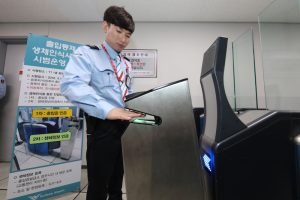The new system accurately captures biometric information from a person’s fingers by means of a 3D image via motion detection.
As part of ongoing efforts to improve airport security hardware, Incheon International Airport Corporation (IIAC) has announced, in a press release dated last month, upgrades to the existing biometric security systems for employees. The recent upgrade features a “non-contact fingerprint recognition” system, and is intended to enhance airport security and efficiency.
The new system employs a technique known as “non-contact fingerprint recognition”; excluding the thumb, this system accurately captures biometric information from a person’s fingers by means of a “3D image (generated) via motion detection”, according to the press release. Compared to existing biometric security systems which require physical contact, the new “non-contact fingerprint recognition” systems record a higher recognition rate. The lack of physical contact also makes the new systems more hygienic.
Additionally, unlike existing biometric security systems, the new “non-contact fingerprint recognition” system is able to collect biometric data without having the person “remain stationary”, and “fingerprint recognition is automatically performed just once”.
The deployment of the new system is not intended to replace existing biometric security systems, but complement them. By using both systems simultaneously, IIAC hopes to boost employee gate security via a two-step authentication process — once via the new non-contact recognition, and a second time via physical scans by current biometric security systems.
A trial run of the new system is currently underway at the east staff exit of Incheon Airport’s Terminal 1. The scale of future deployment of the new system will be determined by the pilot test results.
“I will review the pilot operation results of the (new systems) and expand it to the entire (airport) by 2020,” said Chung Il-Young, president of IIAC. “We will also consider introducing it to passenger areas in future”. President Chung also pledged to make Incheon Airport “clean, convenient and safe with zero defects”.
The recent implementation of the new security systems is part of Incheon Airport’s modernisation program to maintain international competitiveness and upholds its image as a world-class airport. The IIAC has sought to achieve this via investments in enhancing and expanding airport infrastructure, participating in international research partnerships, as well as improving customer service and airport security by installing new hardware. Robots deployed by LG are currently being used at Incheon Airport to guide travellers as well as maintain airport cleanliness; last month, “Drop&Fly” self-service bag drop units were also deployed at Incheon Airport’s Terminal 2, making baggage drop-off more convenient for travellers and baggage handling more accurate and secure.
Incheon International Airport has ranked consistently within the top 10 airports the world, according to Skytrax. The airport’s range of amenities such as a golf course, spa, and private lounges and excellence in customer service has received much international praise, and the IIAC emphasises on improving the customer experience as part of its ongoing airport modernisation initiatives.
Still, the IIAC’s emphasis on improving hardware and infrastructure does not address other pressing issues. In 2016, a Chinese couple and 25-year old Vietnamese man evaded Korean immigration and entered the country illegally; similarly in April this year, a sex offender identified as Shin managed to slip past airport security and was only by Vietnamese law enforcement personnel after his plane landed in Ho Chi Minh City, Vietnam. In the dual incidents of 2016, the Chinese couple allegedly got past multiple security gates in a mere 14 minutes; an alarm had gone off when the Vietnamese man forced his way through an automated gate during peak morning hours, but it had gone unnoticed by duty personnel at the time. Experts have highlighted the lack of strong inter-agency coordination, and chronic understaffing of security personnel resulting in undermanned security systems.
source : opengovasia


